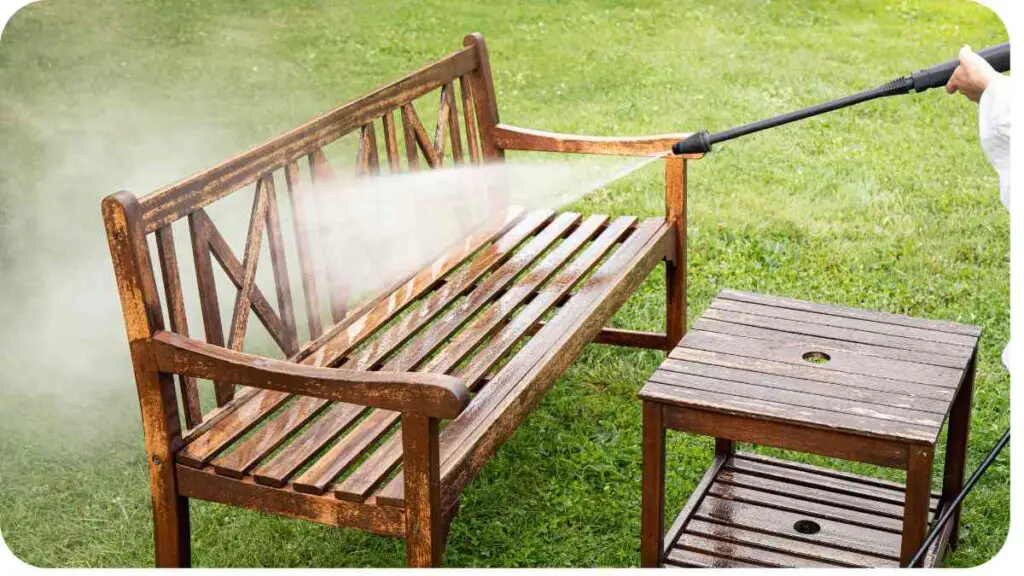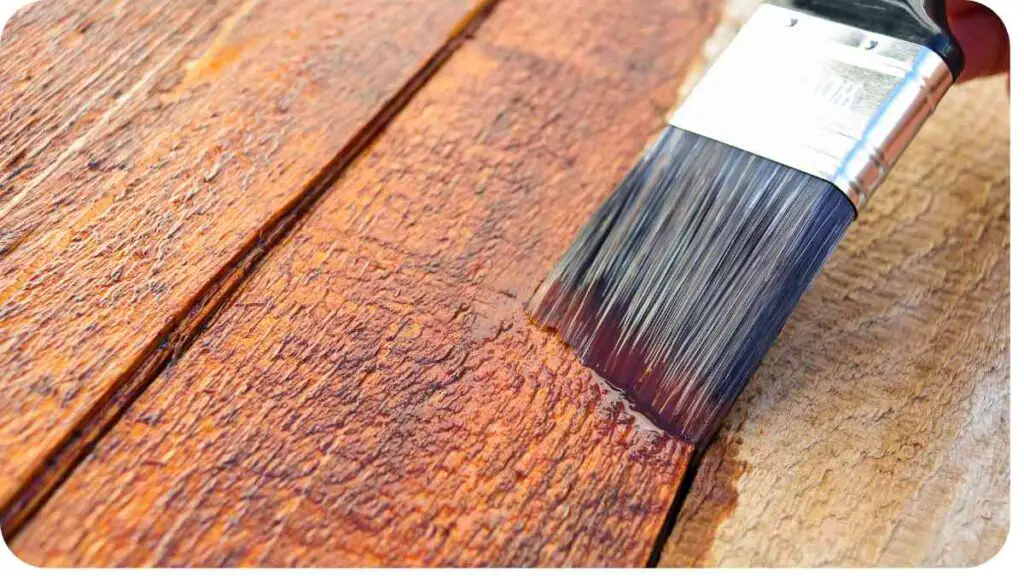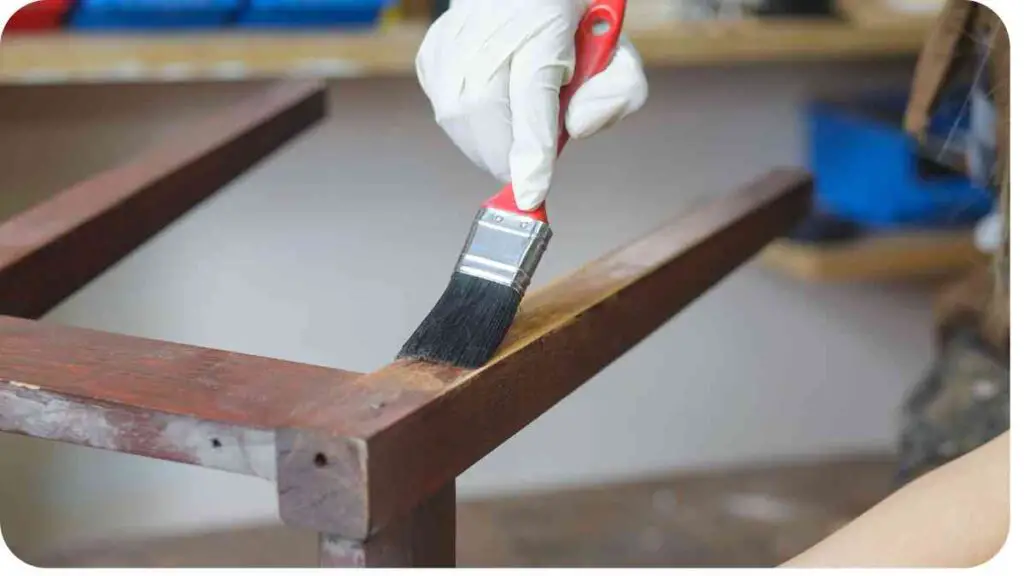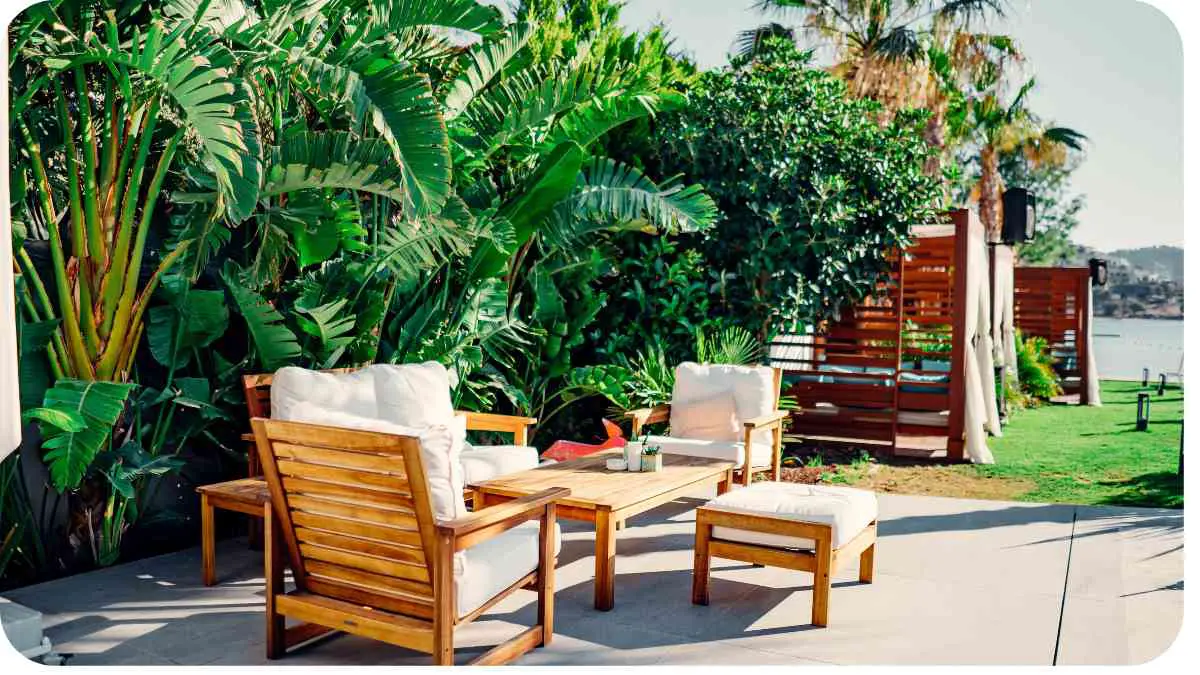Outdoor wooden furniture adds warmth and charm to any outdoor space, but exposure to the elements can take a toll over time, leaving it weathered and worn. However, with the right techniques and a little elbow grease, you can breathe new life into your weathered wooden pieces.
In this guide, we’ll walk you through the steps to effectively restore your weathered wooden outdoor furniture, helping you revive its beauty and prolong its lifespan.
| Key Takeaways |
|---|
| Proper assessment of damage is crucial. |
| Thorough cleaning is essential before restoration. |
| Sanding prepares the surface for staining or sealing. |
| Choose the right stain or sealant for protection. |
| Proper application and protection ensure longevity. |
| Regular maintenance preserves the furniture’s beauty. |
2. Assessing the Damage
Before diving into the restoration process, it’s crucial to assess the extent of the damage to your wooden furniture. Take a close look at the surface for signs of wear, such as cracks, discoloration, or mildew.
Preserving your outdoor wooden structures is essential for longevity. By following effective pest damage prevention techniques, you can ensure their durability and beauty for years to come.” Preserving Your Outdoor Wooden Structures: A Guide to Addressing Pest Damage
Table: Common Signs of Weathered Wooden Furniture
| Sign of Damage | Description |
|---|---|
| Cracks | Fine lines or splits in the wood caused by prolonged exposure to sunlight and moisture. |
| Discoloration | Fading or darkening of the wood due to UV rays, rain, and humidity. |
| Mildew | Black or greenish spots caused by mold growth in damp conditions. |
| Warping | Uneven bending or twisting of the wood caused by changes in temperature and humidity. |
Understanding the specific issues your furniture is facing will help you determine the appropriate restoration steps to take.
3. Cleaning Your Weathered Wooden Furniture

Once you’ve assessed the damage, the next step is to thoroughly clean your weathered wooden furniture. Cleaning helps remove dirt, grime, and mildew buildup, preparing the surface for restoration.
Table: Cleaning Supplies for Weathered Wooden Furniture
| Cleaning Supply | Description |
|---|---|
| Mild Soap | Gentle soap solution to remove dirt and grime without damaging the wood. |
| Soft Bristle Brush | Non-abrasive brush for scrubbing the surface without causing scratches. |
| Bleach Solution | Diluted bleach to kill mold and mildew spores on the wood surface. |
| Pressure Washer | Optional for deep cleaning, but use with caution to avoid damaging the wood. |
Before cleaning, test any cleaning solution on a small, inconspicuous area of the furniture to ensure it doesn’t cause discoloration or damage. Then, follow these steps:
- Mix a mild soap solution in a bucket of warm water.
- Dip the soft bristle brush into the soapy water and scrub the surface of the furniture, working in the direction of the wood grain.
- For stubborn stains or mildew, apply a bleach solution using a separate brush and allow it to sit for a few minutes before rinsing.
- Rinse the furniture thoroughly with clean water to remove any soap or bleach residue.
- Allow the furniture to dry completely before proceeding to the next step.
Cleaning your wooden furniture not only improves its appearance but also ensures better adhesion of the stain or sealant during the restoration process.
Regular maintenance is key to prolonging the lifespan of outdoor tools. With proper care and repair techniques, you can prevent rust buildup and keep your tools in optimal condition for use.” Repairing Rusty Outdoor Tools: Maintenance Tips
4. Sanding and Preparing the Surface
After cleaning, the next crucial step in restoring weathered wooden outdoor furniture is sanding and preparing the surface. Sanding helps smooth out rough areas, remove old finishes, and open up the wood pores for better absorption of the stain or sealant.
Table: Sandpaper Grit Guide for Wooden Furniture
| Sandpaper Grit | Best Used for | Description |
|---|---|---|
| 80-100 | Removing old finish | Coarse grit for stripping old paint or varnish. |
| 120-150 | Smoothing rough surfaces | Medium grit for sanding rough spots and imperfections. |
| 180-220 | Preparing for staining | Fine grit for preparing the surface before staining. |
| 320-400 | Between coats | Very fine grit for sanding between coats of stain or sealant. |
To prepare the surface of your weathered wooden furniture:
- Start with a coarse grit sandpaper (80-100 grit) to remove any existing finish or stubborn stains. Sand in the direction of the wood grain until the surface is smooth.
- Switch to a medium grit sandpaper (120-150 grit) to further smooth out the surface and remove any remaining imperfections.
- Finish sanding with a fine grit sandpaper (180-220 grit) to achieve a smooth, uniform surface that’s ready for staining or sealing.
- After sanding, use a tack cloth to remove any dust or debris from the surface before applying the stain or sealant.
Proper sanding is key to achieving a professional-looking finish on your restored wooden furniture. Take your time and pay attention to detail to ensure the best results.
5. Choosing the Right Stain or Sealant

Selecting the appropriate stain or sealant is crucial for protecting and enhancing the appearance of your weathered wooden outdoor furniture. Consider factors such as the type of wood, desired finish, and level of protection needed against the elements.
Don’t let torn outdoor furniture fabric ruin your outdoor experience. Follow this DIY guide to learn how to repair torn fabric and restore your furniture to its former glory with ease.” Repairing Torn Outdoor Furniture Fabric: DIY Guide
Table: Types of Stains and Sealants for Wooden Furniture
| Type | Description | Pros | Cons |
|---|---|---|---|
| Oil-Based Stain | Penetrates deep into the wood, enhancing natural grain and providing long-lasting color. | Durable, enhances wood’s natural beauty. | Requires longer drying time, may need multiple coats. |
| Water-Based Stain | Quick-drying, low odor, and easy cleanup. Provides a wide range of color options. | Environmentally friendly, minimal odor. | May not penetrate wood as deeply as oil-based stain. |
| Polyurethane Sealant | Provides a durable, protective finish that resists moisture, UV rays, and scratches. | Easy to apply, offers excellent protection. | Can give a plastic-like appearance to the wood. |
| Spar Urethane | Specifically formulated for outdoor use, offers superior protection against moisture and UV damage. | Resistant to weathering and extreme conditions. | Requires careful application to avoid runs or bubbles. |
Consider the specific needs of your outdoor furniture when choosing between stains and sealants. If you want to enhance the natural beauty of the wood while providing long-lasting protection, an oil-based stain may be the best choice. However, if you prefer a quick-drying option with easy cleanup, a water-based stain might be more suitable.
6. Applying the Stain or Sealant
Once you’ve chosen the right stain or sealant for your weathered wooden outdoor furniture, it’s time to apply it to the surface. Proper application is essential for achieving an even finish and maximizing the protective benefits of the product.
Table: Tools for Applying Stain or Sealant
| Tool | Description |
|---|---|
| Brush | Natural bristle brush for applying stain or sealant in long, even strokes. |
| Foam Brush | Disposable foam brush for smaller areas or intricate details. |
| Cloth | Lint-free cloth for wiping off excess stain and achieving a smooth finish. |
| Paint Sprayer | Optional for large surfaces, provides quick and even application. |
Follow these steps for applying stain or sealant to your wooden furniture:
- Stir the stain or sealant thoroughly to ensure it’s well mixed.
- Using a brush or foam brush, apply a thin, even coat of stain or sealant to the wood surface, working in the direction of the grain.
- Allow the first coat to dry according to the manufacturer’s instructions. This may take several hours depending on the product and environmental conditions.
- If necessary, apply additional coats to achieve the desired color or level of protection, allowing each coat to dry completely before applying the next.
- Once the final coat is dry, lightly sand the surface with fine grit sandpaper (320-400 grit) to smooth out any imperfections.
- Wipe off any dust with a clean, lint-free cloth before applying a final coat of sealant for added protection.
Revitalize your outdoor cushions and breathe new life into your outdoor space. Learn effective techniques for restoring faded cushions, ensuring comfort and style in your outdoor living areas.” Restoring Faded Outdoor Cushions
7. Protecting Your Restored Furniture

After applying the stain or sealant, it’s important to take steps to protect your newly restored wooden furniture from future damage and wear. Proper maintenance and protection can help extend the life of your outdoor furniture and keep it looking beautiful for years to come.
Table: Tips for Protecting Restored Wooden Furniture
| Tip | Description |
|---|---|
| Cover or Store Indoors | Protect furniture from prolonged exposure to sunlight, rain, and extreme weather by covering it when not in use or storing it indoors during harsh conditions. |
| Regular Cleaning | Regularly clean furniture with a mild soap solution to remove dirt, debris, and mildew buildup. |
| Apply a UV Protectant | Use a UV protectant spray to shield the wood from the damaging effects of sunlight and prevent fading or discoloration. |
| Reapply Sealant as Needed | Monitor the condition of the sealant and reapply as needed to maintain optimal protection against moisture and UV rays. |
| Avoid Harsh Chemicals | Avoid using harsh chemicals or abrasive cleaners on the wood surface, as they can damage the finish and accelerate wear. |
| Inspect for Damage | Periodically inspect the furniture for signs of damage or wear, such as cracks, warping, or loose joints, and address any issues promptly. |
8. Tips for Maintenance
Maintaining your restored wooden outdoor furniture is key to preserving its beauty and durability over time. With regular care and attention, you can extend the lifespan of your furniture and keep it looking its best season after season.
Wobbly garden structures can detract from the beauty of your outdoor space. Discover how to stabilize pergolas, arbors, and more with simple fixes to ensure they stand strong and sturdy.” Fixing Wobbly Garden Structures: Pergolas, Arbors, and More
Table: Maintenance Schedule for Wooden Outdoor Furniture
| Maintenance Task | Frequency | Description |
|---|---|---|
| Cleaning | Weekly | Clean the furniture with a mild soap solution and water to remove dirt, grime, and debris. |
| Inspection | Monthly | Inspect the furniture for signs of damage, such as cracks, splits, or loose joints. |
| Touch-Up | As needed | Touch up any areas of the finish that may become worn or damaged over time. |
| Reapply Sealant | Annually | Check the condition of the sealant and reapply as needed to maintain protection against moisture and UV rays. |
In addition to regular maintenance tasks, consider the following tips for caring for your wooden outdoor furniture:
- Protective Covers: Invest in protective covers to shield your furniture from the elements when not in use, especially during the off-season or inclement weather.
- Avoid Direct Sunlight: Position your furniture in shaded areas or use umbrellas to minimize exposure to direct sunlight, which can cause fading and deterioration of the wood.
- Use Coasters and Mats: Place coasters or mats under planters, drink glasses, and other items to prevent water rings and stains on the wood surface.
- Rotate Furniture: Periodically rotate or move your furniture to ensure even exposure to sunlight and prevent uneven wear and fading.
- Address Issues Promptly: If you notice any signs of damage or wear, such as loose joints or cracked wood, address them promptly to prevent further deterioration.
9. Conclusion
Restoring weathered wooden outdoor furniture is a rewarding project that can breathe new life into your outdoor space. By following the steps outlined in this guide and implementing proper maintenance practices, you can revive the beauty of your wooden furniture and enjoy it for years to come.
From assessing the damage and cleaning the surface to choosing the right stain or sealant and protecting your restored furniture, each step plays a crucial role in the restoration process. By taking the time to properly care for your wooden furniture, you can prolong its lifespan, enhance its appearance, and create a welcoming outdoor oasis for relaxation and enjoyment.
Remember to regularly clean and inspect your furniture, apply touch-ups and reapply sealant as needed, and protect it from harsh weather conditions to maintain its beauty and durability. With proper care and attention, your restored wooden outdoor furniture will continue to be a cherished centerpiece of your outdoor living space for years to come.
If you have any questions or need further assistance with restoring your weathered wooden furniture, don’t hesitate to reach out to us. We’re here to help you make the most of your outdoor furniture and create an inviting outdoor retreat for yourself and your loved ones.
Happy restoration!
Further Reading
- The Pro Group – Inspiration: Weathered Wooden Outdoor Furniture: Explore inspiring ideas and tips for restoring weathered wooden outdoor furniture.
- Love Grows Wild – How to Restore and Protect Outdoor Wood Furniture: Learn effective techniques for restoring and protecting your outdoor wood furniture.
- Thrifty Decor Chick – How to Restore Weathered Outdoor Furniture: Discover budget-friendly methods for restoring weathered outdoor furniture to its former glory.
FAQs
How can I assess the damage to my weathered wooden outdoor furniture?
To assess the damage, carefully inspect the furniture for signs of cracks, discoloration, mildew, and warping caused by prolonged exposure to the elements.
What cleaning supplies should I use for weathered wooden outdoor furniture?
Use mild soap, a soft bristle brush, bleach solution for mold or mildew, and a pressure washer for deep cleaning (optional, use with caution).
How do I choose the right stain or sealant for my furniture?
Consider factors such as the type of wood, desired finish, and level of protection needed. Options include oil-based stain, water-based stain, polyurethane sealant, and spar urethane.
What tools do I need to apply stain or sealant to my furniture?
You’ll need a brush or foam brush for application, a cloth for wiping off excess, and optionally, a paint sprayer for larger surfaces.
How can I protect my restored wooden furniture from future damage?
Protect your furniture by covering or storing it indoors when not in use, regularly cleaning it, applying a UV protectant, reapplying sealant annually, and avoiding harsh chemicals.

Hi! My name is Hellen James, and I’m here to help you with your home-maintenance needs. Whether it’s building a better yard or just trying to fix a garden—I can show you how.


